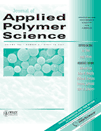Modification of isotactic polypropylene by the free-radical grafting of 1,1,1-trimethylolpropane trimethacrylate
Abstract
The chemical modification of isotactic polypropylene was performed by the free-radical-promoted grafting of 1,1,1-trimethylolpropane trimethacrylate (TMPTMA) in the presence of dicumyl peroxide (DCP) as the initiator. The reaction was carried out both in a batch internal mixer and in a corotating twin-screw extruder; the effects of the peroxide and monomer concentrations on the extent of modification in terms of the grafting efficiency and polymer chain structure variations were investigated. The modified samples were characterized with Fourier transform infrared to determine the structure of the grafted groups and the degree of functionalization, with gel permeation chromatography and the melt flow index to evaluate changes in the molecular weight, and with differential scanning calorimetry, thermogravimetric analysis, and dynamic mechanical thermal analysis to measure the final thermal properties. In addition, solvent extraction with xylene was performed to highlight the presence of gel and its extent. The structure of the grafted groups was determined, and the number of grafted groups was quantitatively evaluated. The degree of functionalization increased with an increasing TMPTMA/DCP molar ratio. Thermal analysis results hinted at the presence of grafted chains with an increased percentage of TMPTMA. Although degradation reactions predominated at high amounts of peroxide, grafting and branching processes became competitive at high levels of TMPTMA. The balance between competing β-scission and grafting/branching reactions could be adjusted on the basis of feed conditions. © 2007 Wiley Periodicals, Inc. J Appl Polym Sci 104: 950–958, 2007




